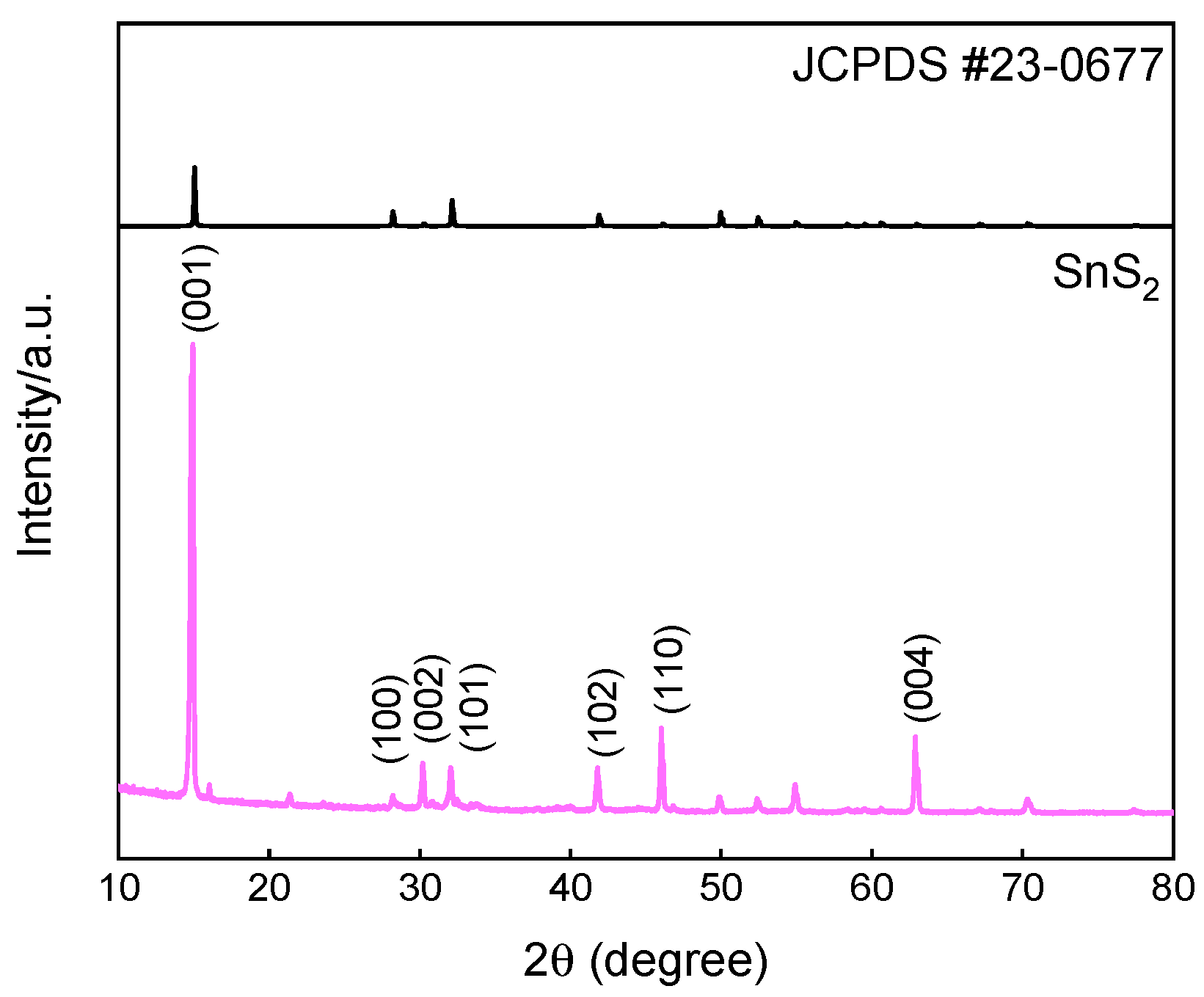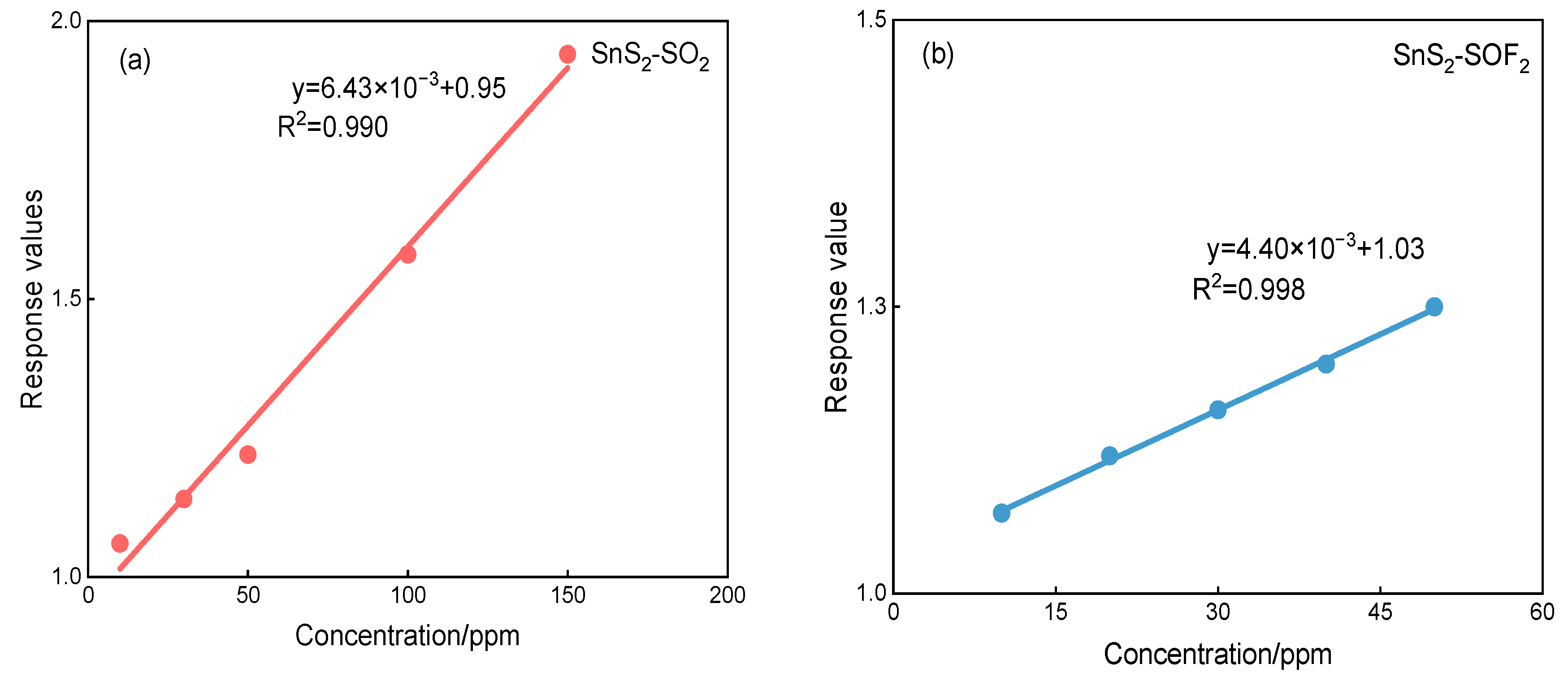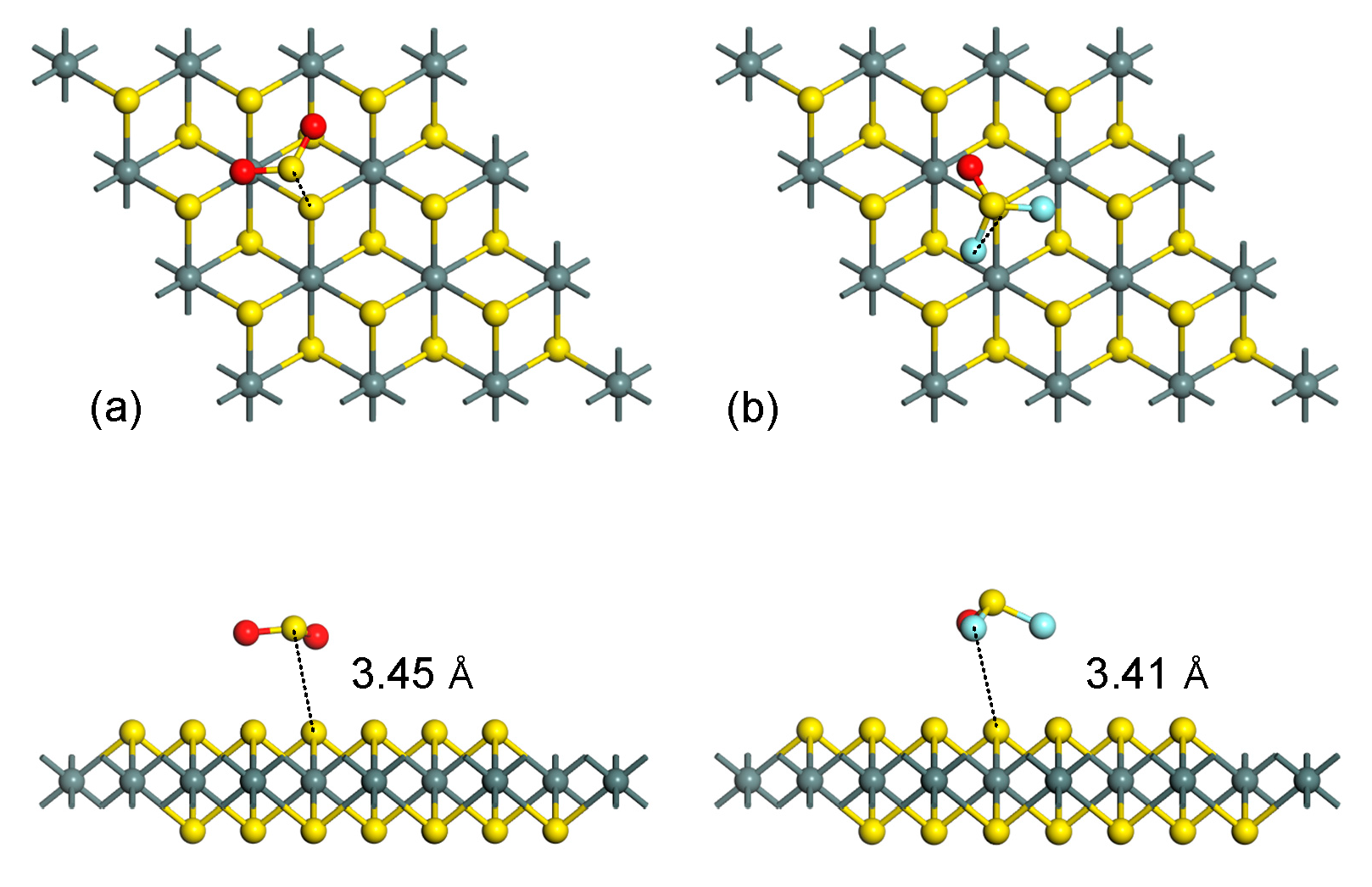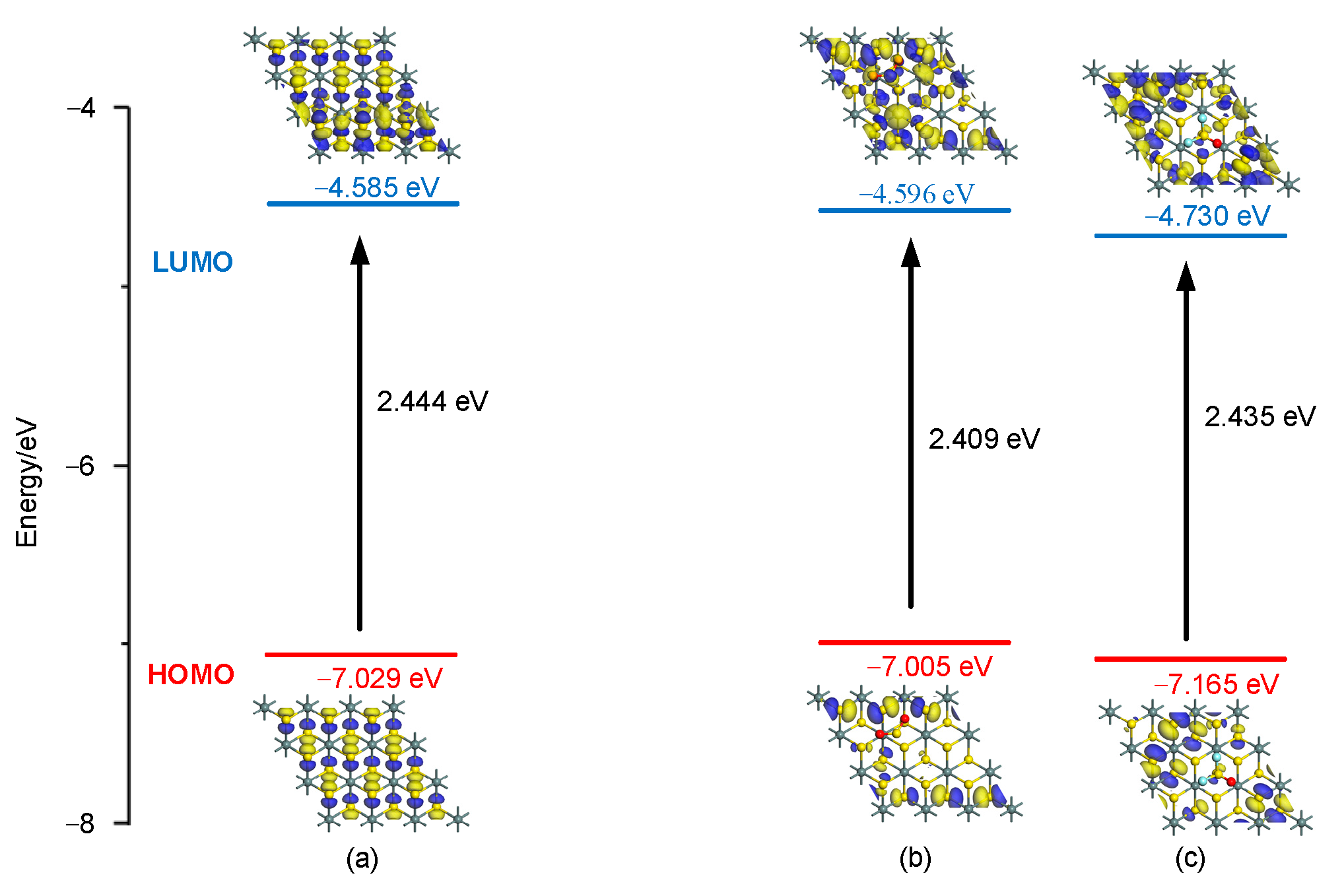Study on the Detection Characteristics and Response Mechanism of SnS2-Based Sensors for SO2 and SOF2
Abstract
:1. Introduction
2. Experimental Section
2.1. Preparation of SnS2 Material
2.2. Preparation of SnS2 Gas Sensor
2.3. Construction of Gas-Sensitive Test Platform and Experimental Process
- (1)
- The device was connected, and the gas tightness of the device was checked.
- (2)
- He was introduced to flush the gas chamber to ensure that no other gases exist inside the gas chamber.
- (3)
- The initial resistance value of the SnS2 gas sensor at room temperature (23 °C) and in a pure He background was measured, recorded as R1. A specific concentration of a single target gas was introduced, where SO2 gas was tested at 150 ppm, while SOF2 gas was set at 50 ppm due to the difficulty of purchasing raw materials for the production of this gas, and only 50 ppm of standard gas could be purchased. After the sensor resistance was stabilized, the value was recorded as Rgas. Finally, the air chamber was cleaned by He, and when the resistance stabilized again, the value was recorded as R2.
- (4)
- The operating temperature gradient was set to: 50 °C, 100 °C, 150 °C, 200 °C, 250 °C, 300 °C and 350 °C, and Step 3 was repeated. The temperature response characteristics of the sensor to the target gas were combined with the recovery of the sensor resistance value to determine its optimal operating temperature.
- (5)
- At the optimal operating temperature, the response values of the sensor to different concentrations of a single target gas were tested (where the concentration gradients were set to 150 ppm, 100 ppm, 50 ppm, 30 ppm and 10 ppm for SO2 gas, and 50 ppm, 40 ppm, 30 ppm, 20 ppm and 10 ppm for SOF2 gas). The concentration–response characteristics of the sensor to the target gas were explored in relation to the response concentration, and the dynamic characteristics of the sensor such as response time, recovery time, sensitivity and stability were analyzed. The response time is the time required for the sensor resistance to reach 90% of its final stable value after the target gas to be measured is introduced. Additionally, the recovery time is the time required for the sensor resistance to return to 90% of the initial resistance value after stopping the target gas to be switched to He.
3. Results and Discussion
3.1. Micro-Structure and Characterization of SnS2
3.2. Gas Sensitivity of the Sensor to SF6 Decomposition Components
3.2.1. Optimum Operating Temperature of SnS2 Gas Sensor
3.2.2. SnS2 Gas Sensor Response
3.2.3. Sensitivity of SnS2 Gas Sensor
3.2.4. Long-Term Stability of SnS2 Gas Sensor
3.3. Response Mechanism Analysis of SnS2 Gas Sensor to SF6 Decomposition Components
4. Conclusions
- (1)
- The best working temperature of the SnS2 sensor for two SF6 decomposition components is 200 °C, and it has high linearity in gas-sensitive performance tests of 10~150 ppm and 10~50 ppm, respectively, with a linear correlation coefficient greater than 0.990.
- (2)
- The sensor is more sensitive to SO2 gas than SOF2 gas at the optimum operating temperature and showed excellent long-term stability in the subsequent 10-day stability test.
- (3)
- The gas-sensitive adsorption model was established, and the distribution of frontier molecular orbitals and the corresponding energies before and after the adsorption of the gas were calculated. The energy gap of the SnS2 surface structure decreased to different degrees after the adsorption of both target gases, which was consistent with the experimental results of the decrease in resistance after the adsorption of SnS2 gas.
Author Contributions
Funding
Institutional Review Board Statement
Informed Consent Statement
Data Availability Statement
Conflicts of Interest
References
- Panchenko, A.N.; Tarasenko, V.F.; Beloplotov, D.V.; Panchenko, N.A.; Lomaev, M.I. Diffuse discharges in SF6 and mixtures of SF6 with H2, formed by nanosecond voltage pulses in non-uniform electric field. High Volt. 2018, 3, 316–322. [Google Scholar] [CrossRef]
- Li, Y.; Zhang, X.; Zhang, J.; Fu, M.; Zhuo, R.; Luo, Y.; Chen, D.; Xiao, S. Experimental study on the partial discharge and AC breakdown properties of C4F7N/CO2 mixture. High Volt. 2019, 4, 12–17. [Google Scholar] [CrossRef]
- Wu, Y.J.; Ding, D.; Wang, Y.; Zhou, C.; Lu, H.; Zhang, X. Defect recognition and condition assessment of epoxy insulators in gas insulated switchgear based on multi-information fusion. Measurement 2022, 190, 10. [Google Scholar] [CrossRef]
- Khan, B.; Saleem, J.; Khan, F.; Faraz, G.; Ahmad, R.; Ur Rehman, N.; Ahmad, Z. Analysis of the dielectric properties of R410A gas as an alternative to SF6 for high-voltage applications. High Volt. 2019, 4, 41–48. [Google Scholar] [CrossRef]
- Wang, Y.; Ding, D.; Zhang, Y.; Yuan, Z.; Tian, S.; Zhang, X. Research on infrared spectrum characteristics and detection technology of environmental-friendly insulating medium C5F10O. Vib. Spectrosc. 2022, 118, 103336. [Google Scholar] [CrossRef]
- Foruzan, E.; Akmal, A.A.S.; Niayesh, K.; Lin, J.; Sharma, D.D. Comparative study on various dielectric barriers and their effect on breakdown voltage. High Volt. 2018, 3, 51–59. [Google Scholar] [CrossRef]
- Zhang, X.X.; Liu, J.C.; Wang, J.; Wang, Z. Detection of SF6 decomposition components by pristine and Cr-doped GaN based on the first-principles theory. Comput. Theor. Chem. 2021, 1205, 113431. [Google Scholar] [CrossRef]
- Zhang, X.; Yao, Q.; Tang, J.; Sun, C.; Wan, L. Current status and development of gas component analysis for SF6 Discharge decomposition. High Voltage Eng. 2008, 04, 664–669+747. (In Chinese) [Google Scholar]
- Zhang, L.; Han, X.; Li, J. Partial discharge detection and analysis of needle-plane defect in SF6 under negative oscillating lightning impulse voltage based on UHF method. IEEE Trans. Dielectr. Electr. Insul. 2017, 24, 296–303. [Google Scholar] [CrossRef]
- Zhang, D.; Li, J.; Hui, D. Coordinated control for voltage regulation of distribution network voltage regulation by distributed energy storage systems. Prot. Control. Mod. Power Syst. 2018, 3, 35–42. [Google Scholar] [CrossRef]
- Tang, J.; Zeng, F.; Zhang, X.; Yao, Q.; He, J.; Hou, X. Correlation analysis between formation process of SF6 decomposed components and partial discharge qualities. IEEE Trans. Dielectr. Electr. Insul. 2013, 20, 864–875. [Google Scholar] [CrossRef]
- Liu, Y.; Zhou, Q.; Mi, H.; Wang, J.; Zeng, W. Gas-sensing mechanism of Cr doped SnP3 monolayer to SF6 partial discharge decomposition components. Appl. Surf. Sci. 2021, 546, 149084. [Google Scholar] [CrossRef]
- Yin, X.; Dong, L.; Wu, H.; Ma, W.; Zhang, L.; Yin, W.; Xiao, L.; Jia, S.; Tittel, F.K. Ppb-level H2S detection for SF6 decomposition based on a fiber-amplified telecommunication diode laser and a background-gas-induced high-Q photoacoustic cell. Appl. Phys. Lett. 2017, 111, 031109. [Google Scholar] [CrossRef] [Green Version]
- Dong, M.; Zhang, C.; Ren, M.; Albarracín, R.; Ye, R. Electrochemical and infrared absorption spectroscopy detection of SF6 decomposition products. Sensors 2017, 17, 2627. [Google Scholar] [CrossRef] [Green Version]
- Cui, H.; Zhang, X.; Zhang, J.; Zhang, Y. Nanomaterials-based gas sensors of SF6 decomposed species for evaluating the operation status of high-voltage insulation devices. High Volt. 2019, 4, 242–258. [Google Scholar] [CrossRef]
- Zhang, D.; Wu, J.; Li, P.; Cao, Y. Room-temperature SO2 gas-sensing properties based on a metal-doped MoS2 nanoflower: An experimental and density functional theory investigation. J. Mater. Chem. A 2017, 5, 20666–20677. [Google Scholar] [CrossRef]
- Cui, H.; Zhang, X.; Zhang, G.; Tang, J. Pd-doped MoS2 monolayer: A promising candidate for DGA in transformer oil based on DFT method. Appl. Surf. Sci. 2019, 470, 1035–1042. [Google Scholar] [CrossRef]
- Zhang, D.Z.; Tong, J.; Xia, B.K. Humidity-sensing properties of chemically reduced graphene oxide/polymer nanocomposite film sensor based on layer-by-layer nano self-assembly. Sens. Actuators B Chem. 2014, 197, 66–72. [Google Scholar] [CrossRef]
- Zhang, D.; Sun, Y.E.; Li, P.; Zhang, Y. Facile Fabrication of MoS2-Modified SnO2 Hybrid Nanocomposite for Ultrasensitive Humidity Sensing. ACS Appl. Mater. 2016, 8, 14142–14149. [Google Scholar] [CrossRef]
- Qin, H.; Feng, C.; Luan, X.; Yang, D. First-principles investigation of adsorption behaviors of small molecules on penta-graphene. Nanoscale Res. Lett. 2018, 13, 264. [Google Scholar] [CrossRef]
- Wang, J.; Zhang, X.; Liu, L.; Wang, Z. Adsorption of SF6 Decomposition Products by the S Vacancy Structure and Edge Structure of SnS2: A Density Functional Theory Study. ACS Omega 2021, 6, 28131–28139. [Google Scholar] [CrossRef] [PubMed]
- Guo, S.; Yang, D.; Zhang, S.; Dong, Q.; Li, B.; Tran, N.; Li, Z.; Xiong, Y.; Zaghloul, M.E. Development of a Cloud-Based Epidermal MoSe2 Device for Hazardous Gas Sensing. Adv. Funct. Mater. 2019, 29, 1900138. [Google Scholar] [CrossRef]
- Kim, Y.H.; Phan, D.T.; Ahn, S.; Nam, K.H.; Park, C.M.; Jeon, K.J. Two-dimensional SnS2 materials as high-performance NO2 sensors with fast response and high sensitivity. Sens. Actuators B Chem. 2018, 255, 616–621. [Google Scholar] [CrossRef]
- Cui, H.; Jia, P.; Peng, X.; Li, P. Adsorption and sensing of CO and C2H2 by S-defected SnS2 monolayer for DGA in transformer oil: A DFT study. Mater. Chem. Phys. 2020, 249, 123006. [Google Scholar] [CrossRef]
- Zhang, X.; Wang, J.; Chen, D.; Liu, L. The adsorption performance of harmful gas on Cu doped WS2: A First-principle study. Mater 2021, 28, 102488. [Google Scholar] [CrossRef]
- Zhang, G.Z.; Wang, Z.T.; Zhang, X.X. Theoretical screening into Ru-doped MoS2 monolayer as a promising gas sensor upon SO2 and SOF2 in SF6 insulation devices. Mol. Phys. 2022, 120, 8. [Google Scholar] [CrossRef]
- Zhang, X.X.; Liu, W.T.; Tang, J.; Xiao, P. Study on PD detection in SF6 using multi-wall carbon nanotube films sensor. IEEE Trans. Dielectr. Electr. Insul. 2010, 17, 833–838. [Google Scholar] [CrossRef]
- Zhang, X.X.; Yu, L.; Hu, W.H.; Hu, W. Experimental Sensing and Density Functional Theory Study of H2S and SOF2 Adsorption on Au-Modified Graphene. Adv. Sci. 2015, 2, 1500101. [Google Scholar] [CrossRef]
- Zhang, X.; Yu, L.; Tie, J.; Dong, X. Gas sensitivity and sensing mechanism studies on Au-doped TiO2 nanotube arrays for detecting SF6 decomposed components. Sensors 2014, 14, 19517–19532. [Google Scholar] [CrossRef] [Green Version]
- Chen, D.; Zhang, X.; Tang, J.; Cui, H.; Pi, S.; Cui, Z. Adsorption of SF6 decomposed products over ZnO(101̅0): Effects of O and Zn vacancies. ACS Omega. 2018, 3, 18739–18752. [Google Scholar] [CrossRef] [Green Version]
- Wang, J.; Zhang, X.; Liu, L.; Wang, Z. Dissolved gas analysis in transformer oil using Ni-Doped GaN monolayer: A DFT study. Superlattices Microstruct. 2021, 159, 107055. [Google Scholar] [CrossRef]
- Liu, W.; Qiu, X.; Song, Y.; Zhang, X.; Tian, S.; Liu, L. Adsorption behaviour of CF4 and COF2 gas on the GaN monolayer doped with Pt catalytic: A first-principles study. Surf. Sci. 2022, 719, 6. [Google Scholar] [CrossRef]
- Wan, Q.; Xu, Y.; Chen, X.; Xiao, H. Exhaled gas detection by a novel Rh-doped CNT biosensor for prediagnosis of lung cancer: A DFT study. Mol. Phys. 2018, 116, 2205–2212. [Google Scholar] [CrossRef]
- Chen, D.; Tang, J.; Zhang, X.; Cui, H.; Li, Y. Sulfur dioxide adsorbed on pristine and Au dimer decorated γ-graphyne: A density functional theory study. Appl. Surf. Sci. 2018, 458, 781–789. [Google Scholar] [CrossRef]
- Cui, H.; Zhang, G.; Zhang, X.; Tang, J. Rh-doped MoSe2 as toxic gas scavenger: A first-principles study. Nanoscale Adv. 2019, 1, 772–780. [Google Scholar] [CrossRef] [PubMed] [Green Version]
- Chen, D.; Zhang, X.; Cui, H.; Tang, J.; Pi, S.; Cui, Z.; Li, Y.; Zhang, Y. High selectivity n-type InSe monolayer toward decomposition products of sulfur hexafluoride: A density functional theory study. Appl. Surf. Sci. 2019, 479, 852–862. [Google Scholar] [CrossRef]
- Cui, H.; Zhang, X.; Li, Y.; Chen, D.; Zhang, Y. First-principles insight into Ni-doped InN monolayer as a noxious gases scavenger. Appl. Surf. Sci. 2019, 494, 859–866. [Google Scholar] [CrossRef]
- Sharma, A.; Khan, M.S.; Husain, M.; Khan, M.S.; Srivastava, A. Sensing of CO and NO on Cu-doped MoS2 monolayer based single electron transistor: A first principles study. IEEE Sens. J. 2018, 18, 2853–2860. [Google Scholar] [CrossRef]












| Gas-Sensitive Materials | Test Components | Response | Operating Temperature | Response Recovery Time | Background Gases |
|---|---|---|---|---|---|
| Carbon Nanotubes [27] | SOF2 | −1.6% (20 ppm) | room temperature | ~1000 s/– | He |
| Graphene [28] | SOF2 | −0.4% (50 ppm) | room temperature | ~160 s/– | N2 |
| TiO2 Nanotubes [29] | SO2 | −75% (50 ppm) | 180℃ | ~500 s/– | N2 |
| SOF2 | −8% (50 ppm) | 200℃ | –/– | N2 | |
| SnS2 | SO2 | 1.22 (50 ppm) | 200℃ | 60 s/40 s | He |
| SOF2 | 1.12 (20 ppm) | 200℃ | 60 s/40 s | He |
Publisher’s Note: MDPI stays neutral with regard to jurisdictional claims in published maps and institutional affiliations. |
© 2022 by the authors. Licensee MDPI, Basel, Switzerland. This article is an open access article distributed under the terms and conditions of the Creative Commons Attribution (CC BY) license (https://creativecommons.org/licenses/by/4.0/).
Share and Cite
Li, C.; He, M.; Tian, S.; Yuan, J.; Wang, J.; Li, Y. Study on the Detection Characteristics and Response Mechanism of SnS2-Based Sensors for SO2 and SOF2. Chemosensors 2022, 10, 526. https://doi.org/10.3390/chemosensors10120526
Li C, He M, Tian S, Yuan J, Wang J, Li Y. Study on the Detection Characteristics and Response Mechanism of SnS2-Based Sensors for SO2 and SOF2. Chemosensors. 2022; 10(12):526. https://doi.org/10.3390/chemosensors10120526
Chicago/Turabian StyleLi, Chengjun, Mengyang He, Shuangshuang Tian, Jiawei Yuan, Jincong Wang, and Yi Li. 2022. "Study on the Detection Characteristics and Response Mechanism of SnS2-Based Sensors for SO2 and SOF2" Chemosensors 10, no. 12: 526. https://doi.org/10.3390/chemosensors10120526





